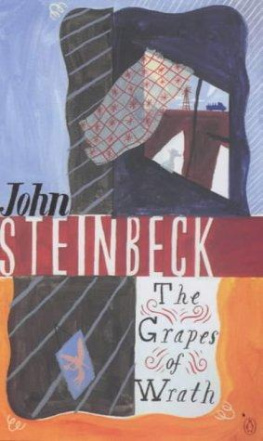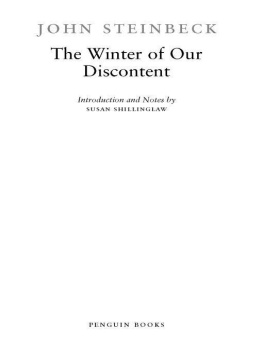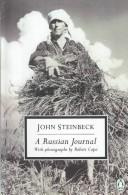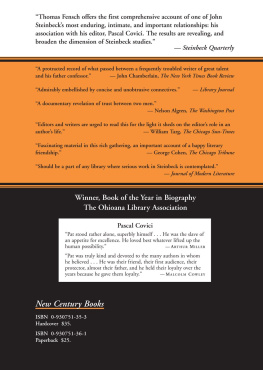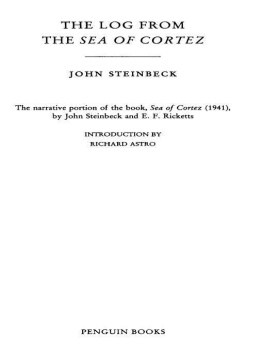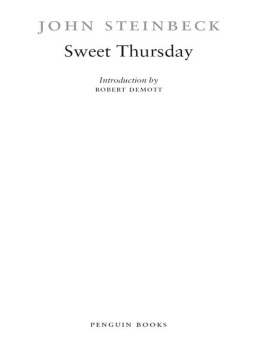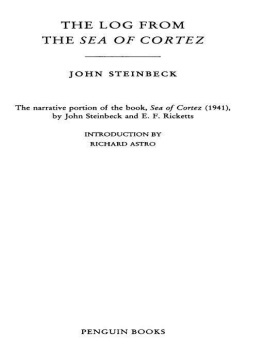John Steinbeck - The Red Pony
Here you can read online John Steinbeck - The Red Pony full text of the book (entire story) in english for free. Download pdf and epub, get meaning, cover and reviews about this ebook. year: 1993, publisher: Penguin Group, genre: Detective and thriller. Description of the work, (preface) as well as reviews are available. Best literature library LitArk.com created for fans of good reading and offers a wide selection of genres:
Romance novel
Science fiction
Adventure
Detective
Science
History
Home and family
Prose
Art
Politics
Computer
Non-fiction
Religion
Business
Children
Humor
Choose a favorite category and find really read worthwhile books. Enjoy immersion in the world of imagination, feel the emotions of the characters or learn something new for yourself, make an fascinating discovery.

- Book:The Red Pony
- Author:
- Publisher:Penguin Group
- Genre:
- Year:1993
- Rating:5 / 5
- Favourites:Add to favourites
- Your mark:
- 100
- 1
- 2
- 3
- 4
- 5
The Red Pony: summary, description and annotation
We offer to read an annotation, description, summary or preface (depends on what the author of the book "The Red Pony" wrote himself). If you haven't found the necessary information about the book — write in the comments, we will try to find it.
The Red Pony — read online for free the complete book (whole text) full work
Below is the text of the book, divided by pages. System saving the place of the last page read, allows you to conveniently read the book "The Red Pony" online for free, without having to search again every time where you left off. Put a bookmark, and you can go to the page where you finished reading at any time.
Font size:
Interval:
Bookmark:
PENGUIN BOOKS
Born in Salinas, California, in 1902, John Steinbeck grew up in a fertile agricultural valley about twenty-five miles from the Pacific Coast and both valley and coast would serve as settings for some of his best fiction. In 1919 he went to Stanford University, where he intermittently enrolled in literature and writing courses until he left in 1925 without taking a degree. During the next five years he supported himself as a labourer and journalist in New York City, all the time working on his first novel, Cup of Gold (1929). After marriage and a move to Pacific Grove, he published two Californian fictions, The Pastures of Heaven (1932) and To a God Unknown (1933), and worked on short stories later collected in The Long Valley (1938). Popular success and financial security came only with Tortilla Flat (1935), stories about Montereys paisanos. A ceaseless experimenter throughout his career, Steinbeck changed course regularly. Three powerful novels of the late 1930s focused on the Californian labouring class: In Dubious Battle (1936), Of Mice and Men (1937) and the book considered by many his finest, The Grapes of Wrath (1939). Early in the 1940s, Steinbeck became a filmmaker with The Forgotten Village (1941) and a serious student of marine biology with Sea of Cortez (1941). He devoted his services to the war, writing Bombs Away (1942) and the controversial play-novelette The Moon is Down (1942). Cannery Row (1945), The Wayward Bus (1947), The Pearl (1947), A Russian Journal (1948), another experimental drama, Burning Bright (1950), and The Log from the Sea of Cortez (1951) preceded publication of the monumental East of Eden (1952), an ambitious saga of the Salinas Valley and his own familys history. The last decades of his life were spent in New York City and Sag Harbor with his third wife, with whom he travelled widely. Later books include Sweet Thursday (1954), The Short Reign of Pippin IV: A Fabrication (1957), Once There Was a War (1958), The Winter of Our Discontent (1961), Travels with Charley in Search of America (1962), America and Americans (1966) and the posthumously published Journal of a Novel: The East of Eden Letters (1969), Viva Zapata! (1975), The Acts of King Arthur and His Noble Knights (1976) and Working Days: The Journals of The Grapes of Wrath (1989). He died in 1978, having won a Nobel Prize in 1962.
John Seelye is Graduate Research Professor at the University of Florida, where he teaches American Studies. His books include Prophetic Waters: The River in Early American Life and Literature (1977), Beautiful Machine: Rivers and the American Republic (1991) and Memorys Nation: The Place of Plymouth Rock (1998). He has also written fiction, including The Kid (1972, 1982), a Western.
JOHN STEINBECK
With an Introduction by John Seelye

PENGUIN BOOKS
PENGUIN BOOKS
Published by the Penguin Group
Penguin Books Ltd, 27 Wrights Lane, London W8 5TZ, England
Penguin Putnam Inc., 375 Hudson Street, New York, New York 10014, USA
Penguin Books Australia Ltd, Ringwood, Victoria, Australia
Penguin Books Canada Ltd, 10 Alcorn Avenue, Toronto, Ontario, Canada M4V 3B2
Penguin India (P) Ltd, 11, Community Centre, Panchsheel Park, New Delhi 110 017, India
Penguin Books (NZ) Ltd, Private Bag 102902, NSMC, Auckland, New Zealand
Penguin Books (South Africa) (Pty) Ltd, 5 Watkins Street, Denver Ext 4, Johannesburg 2094, South Africa
Penguin Books Ltd, Registered Offices: Harmondsworth, Middlesex, England
First published in the USA by Covici, Friede, Inc. 1937
Published with The Leader of the People by The Viking Press 1945
First published in Great Britain with Of Mice and Men by William Heinemann Ltd 1940
Published with The Pearl in a Viking Compass edition 1965
Published in Penguin Books 1976
The Red Pony published in Penguin Books 1993
This edition published in the USA in Penguin Books 1994
Published in Great Britain in Penguin Classics 2000
1
Copyright 1933, 1937, 1938 by John Steinbeck
Copyright renewed John Steinbeck, 1961, 1965
Introduction copyright John Seelye, 1994
All rights reserved
The moral right of the author of the introduction has been asserted
Except in the United States of America, this book is sold subject
to the condition that it shall not, by way of trade or otherwise, be lent,
re-sold, hired out, or otherwise circulated without the publishers
prior consent in any form of binding or cover other than that in
which it is published and without a similar condition including this
condition being imposed on the subsequent purchaser
When I was a student in high school, Steinbeck was one of my favorite authors. He is a writer whose simple, straightforward language and realistic even violent plots are attractive to young readers making a first encounter with serious modern literature. I read Tortilla Flat, Cannery Row, Grapes of Wrath, even The Moon Is Downthe Second World War was just over and the issues were still freshbut I did not read The Red Pony, which had recently been published as a single and amplified text, with color illustrations. I think the pictures may have put me off. They suggest that the series of short stories is a childrens book, which it is notand more pertinent to my own youthful bigotries, they certified that it was a book about horses, a genre that for whatever reasons I associated with young females in jodhpurs and boots. The Red Pony is most assuredly not that, either.
So I was wrong on all scores, not the first time during my adolescent yearsor afterwardand here at long last I have an opportunity to make up for that ignorant omission.
I would like to acknowledge my indebtedness to Jack Benson and Linda Wagner-Martin for their helpful and encouraging remarks concerning this introduction.
But let me begin by declaring that I have had considerable company in mistaking this book for something it is not, for in reading it the first time through I also consulted the critical literature on this text, which for the most part misconstrues what I take to be its meaning and intent, thanks to assumptions not too far different from my adolescent prejudices. I will come to that mistaken reading in due course (and proportion). What follows is not chiefly an argument with other critics. It is, however, an attempt to demonstrate that Steinbecks cycle of stories about a boy who has a series of painful even traumatic experiences on the threshold to adolescence may be a slender book, but in this it can be compared to the pin that holds two hinges together. Not only is it a text central to Steinbecks development as a writer but it is a transitional work in the development of literature intended for just the sort of reader I was when first encountering Steinbecks novels and stories.
The importance, in these dual regards of The Red Pony was hardly a matter of authorial intention. At the time he wrote the stories about young Jody Tiflin, Steinbeck was concentrating chiefly on getting through a very difficult period in his life. True, many of Steinbecks works were written during times of crisis, some of his own making, as if the author thrived on emotional turmoil, escaping into the much more tidy world of his own creation yet bringing along the heightened sensibilities that conflict engenders. But the authors troubles during the time he was writing the
Next pageFont size:
Interval:
Bookmark:
Similar books «The Red Pony»
Look at similar books to The Red Pony. We have selected literature similar in name and meaning in the hope of providing readers with more options to find new, interesting, not yet read works.
Discussion, reviews of the book The Red Pony and just readers' own opinions. Leave your comments, write what you think about the work, its meaning or the main characters. Specify what exactly you liked and what you didn't like, and why you think so.

